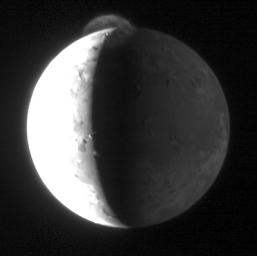
|
A “Plumefall” on Io
- Click the image above for a larger view
- Full-Res JPEG (399 x 397) (12.0 kB)
- Full-Res TIFF (399 x 397) (158.8 kB)
Caption:
New Horizons took this image of Jupiter's volcanic moon Io with its Long Range Reconnaissance Imager (LORRI) at 15:15 Universal Time on February 28, 2007, nearly 10 hours after the spacecraft's closest approach to Jupiter. The image is centered at Io coordinates 5 degrees south, 92 degrees west, and the spacecraft was 2.4 million kilometers (1.5 million miles) from Io. Io's diameter is 3,640 kilometers (2,262 miles).
Io's dayside was deliberately overexposed in this image to bring out details on the nightside and in any volcanic plumes that might be present. Io cooperated by producing an enormous plume, 330 kilometers (200 miles) high, from the volcano Tvashtar. Near Io's north pole, Tvashtar was active throughout New Horizons' Jupiter encounter.
In this image, volcanic debris from the plume, illuminated by the setting sun, rains down onto Io's nightside. Hot, glowing lava at the source of the plume is the bright point of light on the sunlit side of the terminator (the line separating day and night). Elsewhere along the terminator, mountains catch the setting sun. The nightside of Io is lit up by light reflected from Jupiter.
Cataloging Keywords:
| Name | Value | Additional Values |
|---|---|---|
| Target | Io | Jupiter |
| System | Jupiter | |
| Target Type | Satellite | Planet |
| Mission | New Horizons | |
| Instrument Host | New Horizons | |
| Host Type | Flyby Spacecraft | |
| Instrument | Long Range Reconnaissance Imager (LORRI) | |
| Detector | ||
| Extra Keywords | Grayscale, Mountain, Plume, Visual, Volcano | |
| Acquisition Date | ||
| Release Date | 2007-05-01 | |
| Date in Caption | 2007-02-28 | |
| Image Credit | NASA/Johns Hopkins University Applied Physics Laboratory/Southwest Research Institute | |
| Source | photojournal.jpl.nasa.gov/catalog/PIA09360 | |
| Identifier | PIA09360 | |
